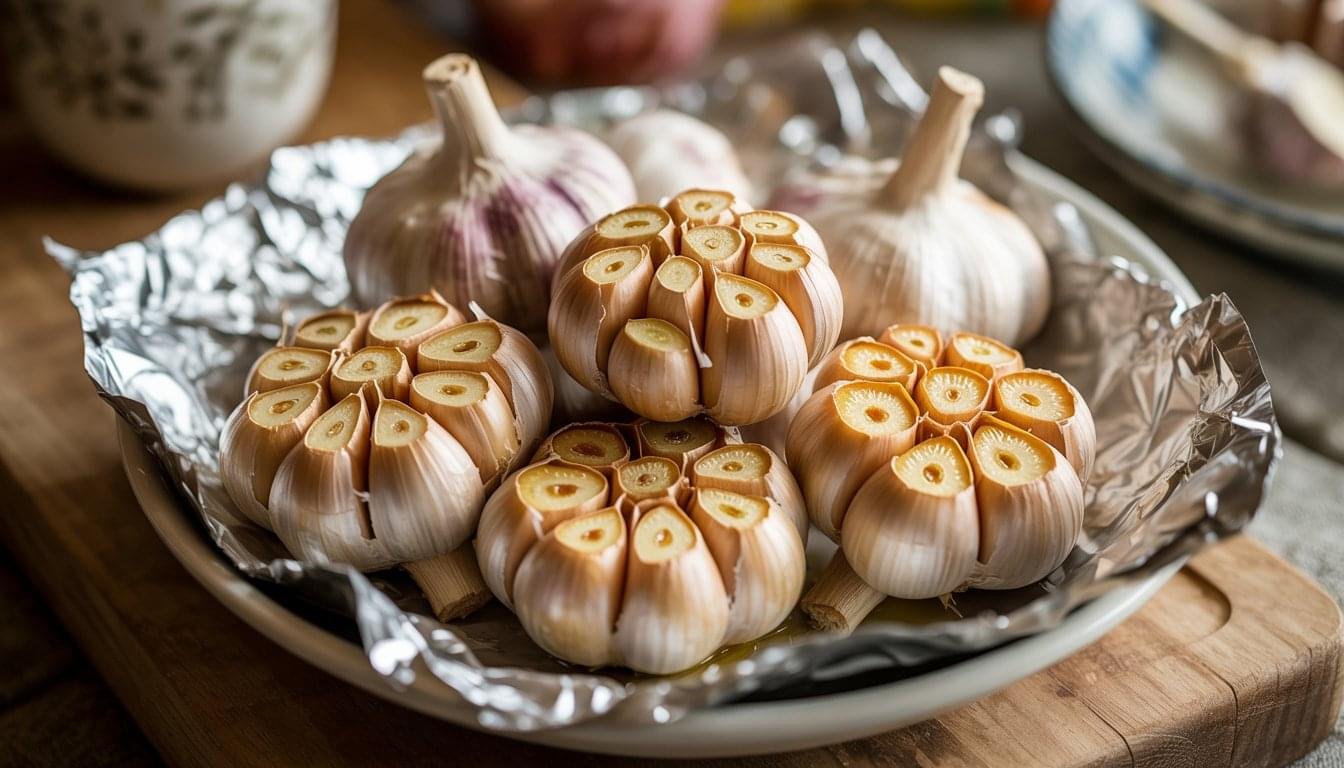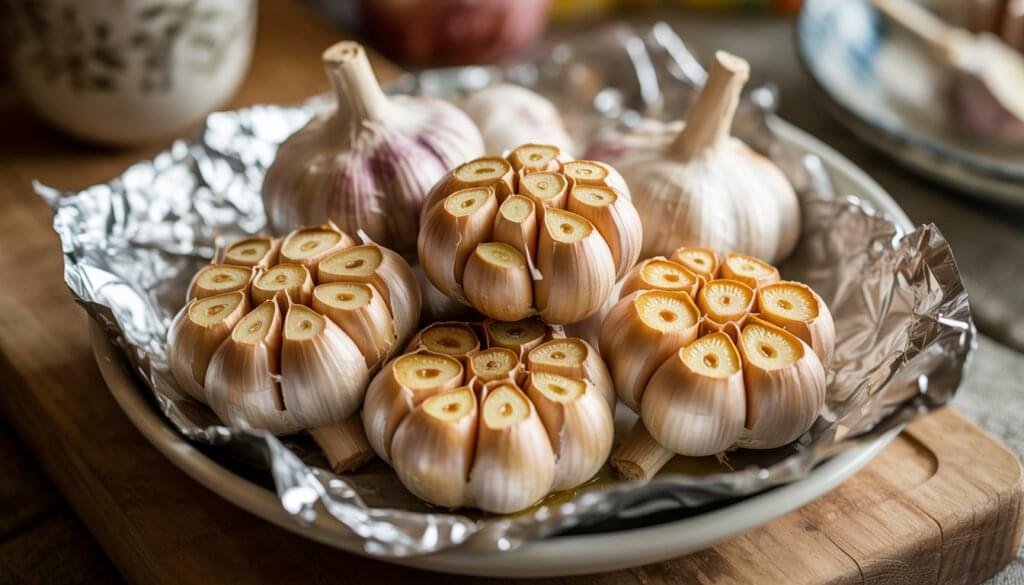
What Is Roasted Garlic and Why You Should Care
Roasted Garlic is just fresh garlic that has been slowly baked in the oven, until it becomes soft, sweet, and intensely flavoured. When you roast garlic, it’s kind of like a magic trick, the sharpness you taste is just completely gone and it becomes sweet and nutty and caramelized in a way that raw garlic is not.
During roasting, sulfur compounds in garlic (thiosulfinates, such as allicin) are degraded, while other Maillard-derived aromas (pyrazines and pyridines) are formed, which contribute to roasted garlic characteristically sweet-nutty profile. What you have is a creamy, almost buttery mouthfeel, and a rich flavor that is a boost to just about anything you make.
A lot of home cooks feel that roasting garlic is difficult, but, really, it is one of the simplest cooking maneuvers you can pull off. All you need is a little bit of know how and you will be on your way to making this fantastic ingredient that will infuse your cooking with flavor.
The Incredible Healing Health Benefits of Roasting Garlic
Although roasted garlic does taste amazing, let’s consider just how (or IF) healthy it really is with regards to fresh garlic or other garlic supplements.
Heart Health Support
The research on garlic and heart health is almost exclusively on supplements. Allicin is found in raw, crushed garlic, but roasting decreases its production. Although some studies have found small average reductions in blood pressure and LDL (the bad kind) cholesterol, and one or two seem to show a protective effect against hardening of the arteries — it takes a high dose of concentrated supplements to have any effect, not the amount used in a normal serving of roasted garlic for dinner. Roasted garlic should be a treat for your tongue, not as required as a supplement.
Immune System Support
Roasted garlic retains many of the original bioactive compounds from the raw product, albeit with diminished antimicrobial potency as a result of thermal processing. Other helpful compounds linger after cooking, but most of the clinical benefits are seen with supplements, not with the amount found in food; consider roast garlic a yummy additive, not a treatment.
Digestive Benefits
Roasted garlic is generally milder-tasting than raw garlic to many people, but still contains fructans which may cause issues for those with IBS and FODMAP sensitivity. If you are FODMAP-sensitive, flavor your food with garlic-infused oil once the solids have been strained out, for the taste without the fructans that cause digestive distress.
Other Compounds
Heat reduces allicin and some antimicrobial action but some other compounds persist. There is less evidence supporting the use of roasted garlic for health compared to garlic supplements, although the anti-inflammatory properties associated with roasted garlic could still contribute to health.
How to Roast Garlic: The Easiest Methods That Work
Roasting garlic is easier than you imagine. Here are three absolutely foolproof techniques that yield beautiful cuts every single time.
Classic Oven Method
My favorite traditional way of roasting garlic, it’s popular for a reason – it always comes out great.
What You Need:
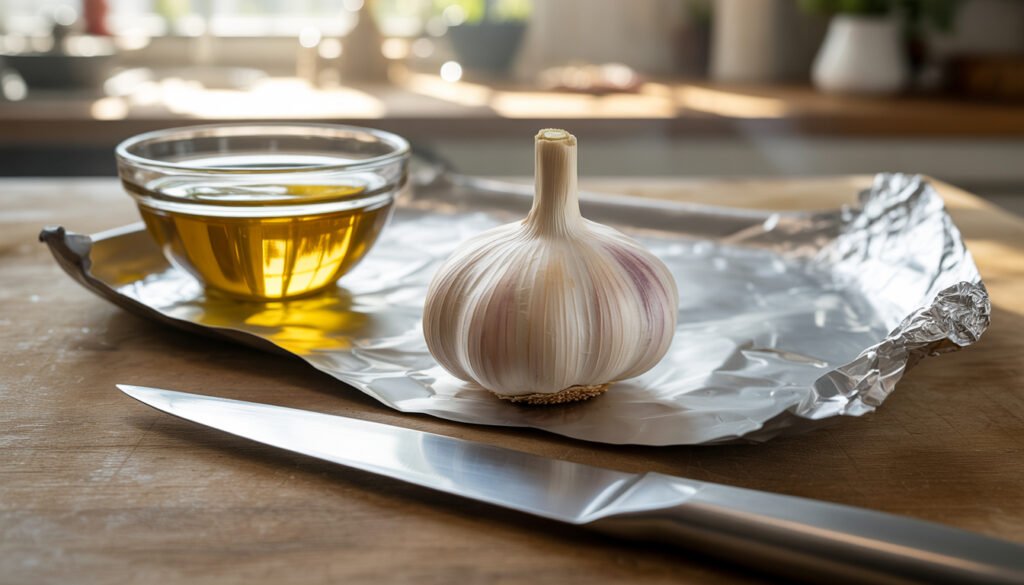
1 whole garlic bulb
1 to 2 tablespoons oil (optional but recommended)
Aluminum foil
Sharp knife
Steps:
1. Turn on your oven and Preheat: 375-400°F (190-200°C)
2. Snip the end off the garlic bulb, so that the top part of the cloves becomes visible.
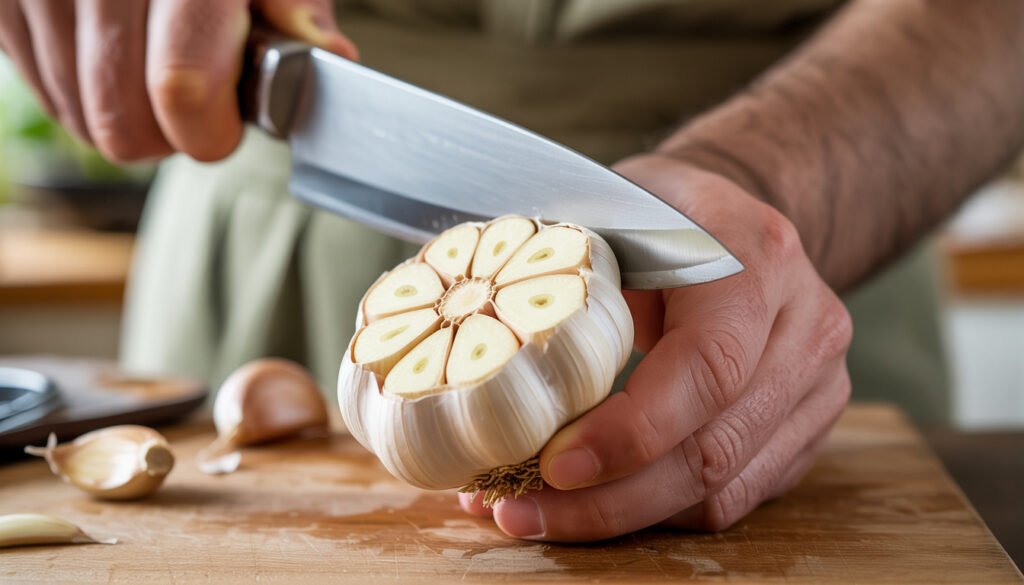
3. Drizzle some olive oil over exposed cloves (to create the heat and moisture transfer)
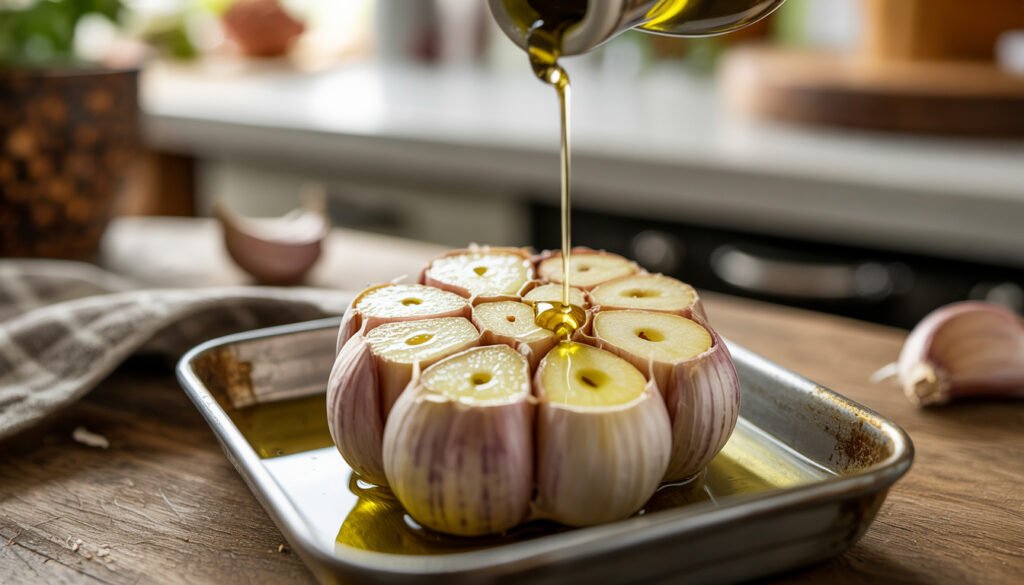
4. Wrap the bulb in foil.
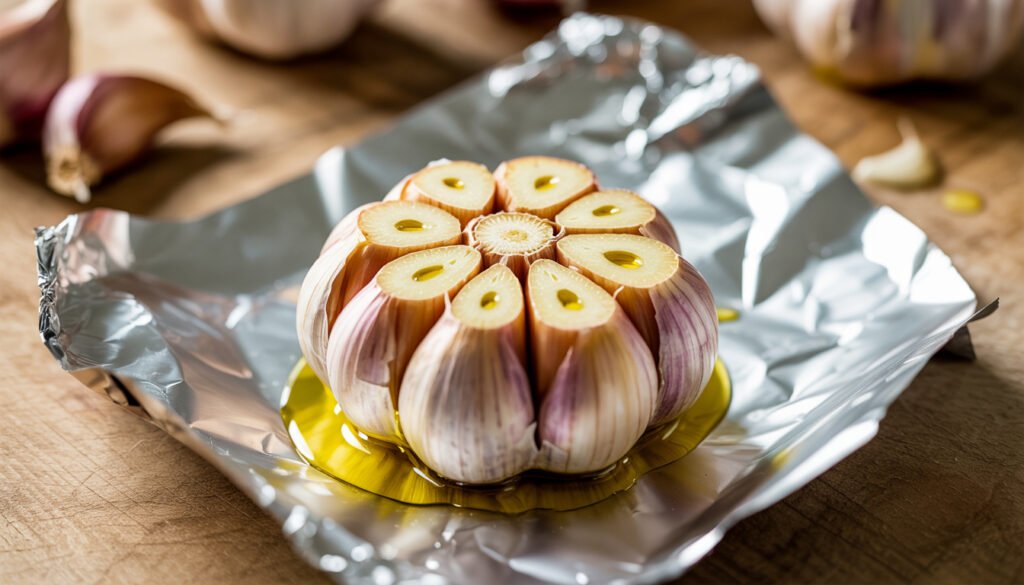
5. Roast for 35-60 minutes, depending on size of bulb and oven, until the cloves are very soft and the tops a light golden.
6. Let cool 5 minutes and then squeeze the roasted garlic cloves from skin.
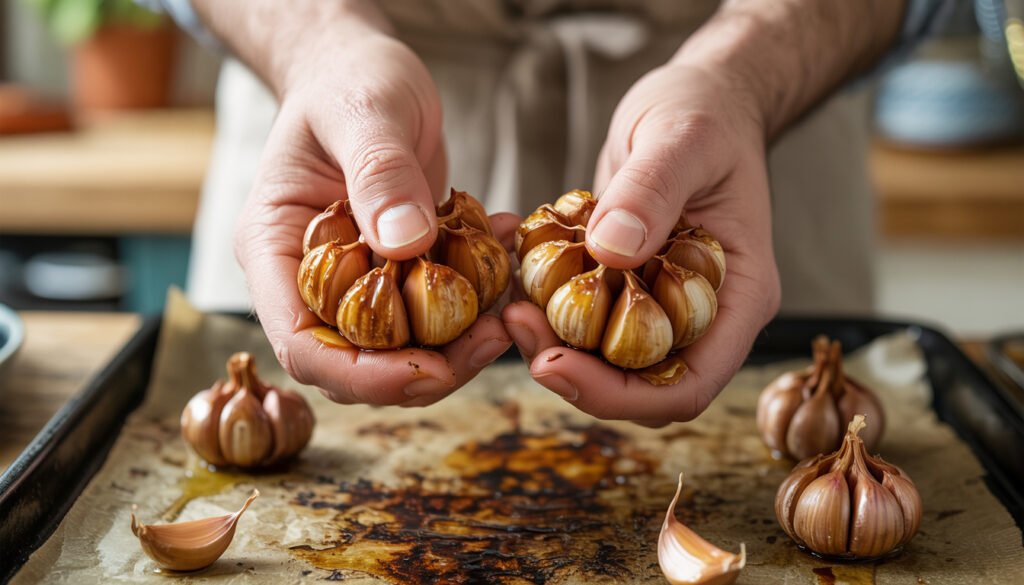
Quick Stovetop Method
For when you want roasted garlic just as fast as you can get it, this pan method will get you there in 10-15.
Steps:
1. Loosen, and if you can stand the mess, peel as many of the cloves of garlic as you can get your hands on (or whatever you want to bear b/c it’s much easier to handle when peeled)
2. and set it over very low heat.
3. Toss in the garlic heads and cook slowly, turning every now and again.
4. Cook for about 10-15 minutes, until it is soft and it becomes a bit toasted.
5. Prevent burning and off flavors by maintaining a low heat throughout
6. Remove and cool before using
Air Fryer Method
An air fryer will make you perfectly roasted garlic in less time than it takes to roast them in the oven.
Steps:
Ingredients: Garlic bulb For oven method instructions see below.
1. Wrap in foil for even cooking
2. Air fryer to 380°F (193°C
3. Cook for 16-20 minutes
4. Check at the half point and add more oil if necessary
5. Creative Uses for Roasted Garlic in the Kitchen {#creative-uses}
6. After your garlic is perfectly roasted, then the real fun starts! This multi-purpose ingredient can elevate everyday-humble dishes, into something amazing.
Spreads and Dips
Mashed with a touch of olive oil and salt, roasted garlic is an awesome spread. Slather it on crusty bread, stir it into cream cheese or add it to hummus for a flavorful spin. Its sweet, soft flavor is a terrific base for appetizers.
Pasta Dishes
Mix roasted garlic into your preferred pasta sauce, or mix hot pasta with roasted garlic cloves, olive oil, and grated parmesan for an easy, satisfying meal. The creaminess just melts into the sauce.
Mashed Potatoes
Stir roasted garlic into your mashed potatoes, which will make it not just richer and creamier but infinitely more interesting than plain potatoes. I would begin with 3-4 cloves per pound of potatoes and add to taste.
Salad Dressings
Stir into vinaigrettes or creamy dressings. Its sweet, mellow taste is especially tasty in caesar or creamy herb dressings when the sharp bite of fresh garlic isn’t the flavor you’re after.
Soups and Stews
Toss roasted garlic into soups and stews a few minutes before serving. It melts into its broth and imparts such an amazing depth of flavor without steamrolling everything else.
Pizza and Flatbreads
Or add a dollop of mashed roasted garlic directly to pizza dough before topping with ingredients; or stir it into ricotta for a delicious white pizza. And it’s just great with herbs and cheese.
HOW TO STORE Roasted Garlic I How long does roasted garlic last?
Roasted garlic is a great taste enhancer, but it needs to be stored properly to keep it fresh and safe to eat and to avoid foodborne illness.
Refrigerator Storage
Refrigerate roasted, unflavored garlic cloves for up to 4 days. Store in an airtight container to prevent them from drying out and picking up other flavors.
Oil Storage Safety
For safety, refrigerate garlic-in-oil at ≤40°F (≤4°C) and use within 4 days; for longer storage, freeze. Never keep garlic-in-oil at room temperature to avoid botulism. The mix of garlic, oil and very little oxygen can create a haven for dangerous bacteria.
Freezer Storage
Freeze-roasted garlic cloves (in oil or plain) in meal-sized portions for a few months; quality is highest within 2-4 months. Freeze in ice cube trays for easy portioning and transfer to freezer bags when frozen.
Safety First
Even with oil the rule still stands as a preventative against botulism _ don’t have the roasted garlic/oil mixture in the refrigerator more than 4 days. If in doubt, it’s safer to freeze longer.
The 5 Most Common Mistakes to Avoid When Roasting Garlic
Although garlic roasting is easy, here’s what you should be aware of so you don’t make common mistakes.
Using Too High Heat
Intensely high heat scorches the outside of garlic long before the inside has a chance to turn soft. Most recommended recipes would try to stay within 375-425°F, but higher temp increase burn odds. Look for signs of color and texture rather than relying on a hard temperature guideline.
Overcooking
Roasted garlic should be golden and soft, not dark brown. Garlic that is overcooked becomes bitter and looses its sweet flavor. Keep an eye on it during the final 10 minutes or so of cooking.
Cutting Too Much Off the Top
You just want to cut away so that the tops of the cloves are exposed. Cutting it too liberally wastes garlic and can leave it too dry after it roasts. A thin slice is all you need.
Not Checking for Doneness
Every oven and head of garlic is unique. Begin checking after 35 minutes, and continue roasting until the cloves feel very soft when gently pressed through the foil.
Roasted Garlic vs Raw Garlic – What is the difference?
Knowing the distinctions among roasted garlic and fresh garlic helps you to select which one works for what recipe.
Flavor Profile
Raw garlic has a strong, spicy taste, as well as compounds like allicin that can be overpowering when consumed in large doses. Roasted garlic is sweet, mellow, and even slightly nutty flavored with none of that hot raw-bite.
Texture Differences
Chopped fresh garlic is crisp and firm. When roasted, garlic becomes sweet and pungent, soft and buttery, even spreadable — well-suited to many uses.
When to Use Each
Use fresh garlic when you want a pronounced taste that slices through rich ingredients or punches up a marinade. Opt for roasted garlic when you want its deep sweet flavor and absolutely no sharpness in spreads, mashes, or subtly flavored things.
Cooking Applications
For stir-fries, marinades and dishes where you want a pronounced garlic flavor, fresh garlic is best. Roasted garlic is great in spreads, mashed into potatoes, blended into sauces, or wherever you desire lightness of garlic flavor.
Nutritional Differences
Raw garlic would contain higher amounts of allicin and some antimicrobial substances. Roasted garlic contains another set of flavor compounds from the cooking process and less of the pungent sulfur compounds that contribute to its health benefits.
Conclusion
Are you ready to experiment with roasted garlic? Begin with the basic oven recipe, and don’t forget that it will keep in the fridge for up to 4 days. Once you experience the sweet, creamy nuttiness of roasted garlic, you’ll discover so many ways to use it. Let us know what you did with your roasted garlic in the comments below we want to hear how you’re using this awesome flavor-booster and all the food safety considerations you keep in mind!
Roasted Garlic FAQs
1. How long does roasted garlic keep?
Roasted garlic kept in the fridge saves for up to 4 days in a sealed storage container. If you keep it in oil, eat it within 4 days and freeze, for safety.
2. Is It Possible to Roast Garlic in Advance?
Yes! Many cooks prefer the way roasted garlic tastes after it’s spent a day in the fridge and the flavors harmonize, so long as it is consumed within the four-day recommended window for safety.
3. Is Roasted Garlic as Nutritious?
Some antimicrobial substances survive, although the heat will decrease allicin and some antimicrobial potato properties. Most of the clinical benefits come from supplements rather than food quantities, so consider roasted garlic a delicious ingredient, not a therapy.
4. Can You Freeze Roasted Garlic?
Absolutely. Roasted garlic may be kept frozen for a few months, with peak quality 2-4 months. It defrosts fast and retains much of its flavor and texture.
5. What Oil Do You Use to Roast Garlic?
For garlic roasting at 375-400°F, olive oil is great, particularly when cloves are wrapped in foil. The oil helps with moisture and heat transfer, though in a strict technical sense it is optional where the roasting is concerned.
6. Is Roasted Garlic Ok for IBS Sufferers?
Roasted garlic still has fructans that will cause IBS symptoms. For FODMAP-sensitive folks you want to add the flavor not the offending compounds, so use garlic-infused oil (with the solids removed).
7. When Does Garlic Get Done Roasting?
Upon slight pressure, roasted garlic cloves should feel very soft, with a light golden hue. They should pop out easily from their papery skins without resistance.
8. Can You Roast Pre-Peeled Garlic?
Yes, you can roast individual peeled cloves, but they will cook quicker and potentially dry out faster. Watch them closely, using a little more oil if they threaten to burn.
